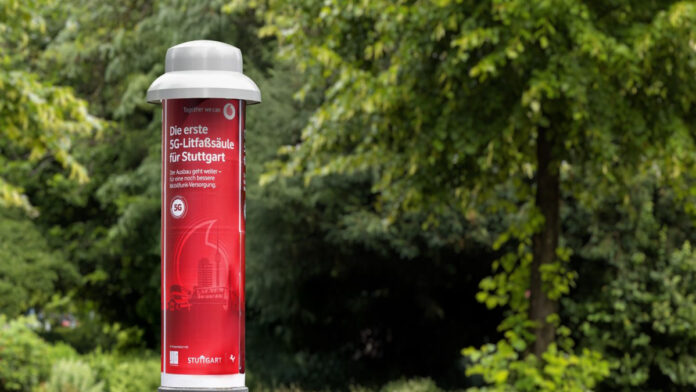Vodafone Germany said that the site, located at Feuerseeplatz, is the first of up to 100 such columns the carrier plans to convert across the city
In sum – what to know:
Stuttgart’s first 5G ad column goes live – Vodafone’s new site at Feuerseeplatz uses an advertising column to improve mobile signal in central Stuttgart.
Plan for 100 5G columns across city – Vodafone and Ilg aim to equip up to 100 columns to boost capacity and coverage in busy streets and public areas.
Discreet design, fast speeds – Ericsson antennas are embedded inside the column roof, offering up to 500 Mbps over a 400-meter radius via fiber backhaul.
Germany telco Vodafone has transformed a traditional advertising column in Stuttgart into a 5G antenna site, marking the launch of a new initiative to improve mobile coverage in urban areas of Baden-Württemberg.
In a release, Vodafone Germany said that the site, located at Feuerseeplatz, is the first of up to 100 such columns the carrier plans to convert across the city.
The upgraded column features integrated Ericsson antennas and technology built into its rooftop and concrete structure. The setup delivers high-speed mobile internet with download speeds of up to 500 Mbps and a coverage radius of approximately 400 meters, using a fiber optic backhaul. The design allows Vodafone to expand its 5G footprint quickly without the need for large cell towers, which are increasingly difficult to site in dense city centers.
The initiative is part of the telco’s broader network expansion strategy to use existing urban infrastructure in creative ways. In Stuttgart alone, there are more than 600 traditional advertising columns, and Vodafone intends to repurpose up to 100 of them. The next 5G-ready columns are already planned for high-footfall areas, including the Mercedes-Benz Museum, MHP Arena and Bad Cannstatt train station.
Michael Jungwirth, member of the management board at Vodafone, said: “People’s hunger for data is growing. This is also the case in Baden-Württemberg. But finding new mobile phone sites is difficult, especially in inner cities. That’s why we’re now also using advertising columns and equipping them with state-of-the-art and particularly small 5G antennas. This is significantly faster than with conventional cell phone masts and represents a technical renaissance for the good old advertising column.”
The German telco has already implemented similar deployments in Düsseldorf, where over 100 advertising columns now serve as 5G micro-sites. Each of these sites handles thousands of daily connections and transmits around 200 gigabytes of data per week.
In October 2024, Vodafone announced the activation of its 5G Standalone (5G SA) network nationwide. In a release, the telco noted that this rollout allows all customers with compatible smartphones to access 5G services for both internet and calls at all 5G locations, eliminating the need to rely on LTE technology.
Previously, Vodafone Germany operated half of its 5G network using the LTE/4G core infrastructure. With the 5G SA offering, customers will get faster connections and significantly lower latency, which is crucial for smooth, lag-free mobile gaming and for applications involving augmented reality (AR) and virtual reality (VR), the telco said.
Vodafone Germany had initially launched its 5G SA network in partnership with Ericsson, Nokia, Qualcomm and Oppo.
Vodafone’s 5G SA technology utilizes frequencies in the 700 MHz, 1.8 GHz and 3.5 GHz ranges. To date, the company has equipped more 16,000 of its 26,000 mobile stations with 5G technology. This means that Vodafone now provides 5G coverage to approximately 92% of the population, with over 90% also having access to 5G SA. By mid-2025, this coverage is expected to reach 95%.
Vodafone Germany also noted that the 5G SA network supports the aggregation of multiple frequencies, enabling speeds in excess of 1,000 Mbps on some smartphones.
Despite the broad availability of the 5G SA network, Vodafone said it continues to run a mixed network, operating both 5G SA and 5G NSA technologies simultaneously. This allows smartphones that are not yet optimized for 5G SA to still benefit from Vodafone’s extensive 5G coverage.

